
Fuel VFX & Method Studios contribute to ‘The Hunger Games: Catching Fire’, producing key FX from elusive holographic characters to Katniss Everdeen’s fiery dress.
PLAYING WITH FIRE |
|
Fuel VFX and Method Studios played active roles in ‘The Hunger Games: Catching Fire’, producing key visual effects across the film from elusive holographic characters to Katniss Everdeen’s fiery dress. Portraying a harsh vision of the future, where most of the world’s population lives under the oppressive regime of the Capitol, the movie’s fast-paced action frequently relies on striking visual effects – including environments, CG animations and simulated effects - to help tell the characters’ dramatic, often violent story. Holographic OpponentFuel VFXin Sydney was assigned an exciting sequence inside the Hunger Games Training Centre where the tributes prepare for the deadly fight for survival they must soon face. As lead character Katniss Everdeen sharpens her archery skills in the Centre’s target practice station, she encounters moving holographic targets generated by laser projection, designed to appear, or ‘draw’, at the convergence of three laser projectors. Each takes shape as an extremely quick and nimble human-like character composed of a fluid collection of small glowing cubes that continuously disperses and reforms as Katniss pursues her with her arrows. |
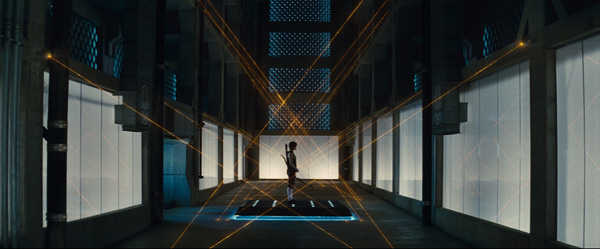 |
|
Fuel VFX started work while the shoot was in still in progress, as their sequence was the first part of the film to be shot and shots were turned over to them quickly. The team had already developed a working relationship with VFX supervisor Janek Sirrs during earlier collaborations such as ‘The Avengers’ and ‘Iron Man 2’. As the team began work, they had no traditional artwork or concepts to start with but Janek talked over with them the look he was after and described his interest in Antony Gormley’s sculpture and how it might inspire development of holographic projections. Some of this artist’s works involve human figures portrayed with cubic and rectangular shapes. The team also explored tessellation effects and different materials as they considered ways the characters might be made to shatter into cubes. |
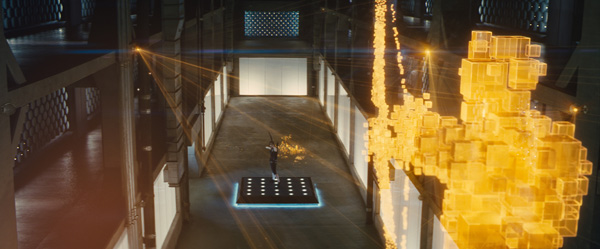 |
Motion Capture“I like inventing elements and solving problems from scratch, as a designer would, instead of going straight for a hard, visual effects solution,” said Paul Butterworth, VFX supervisor at Fula VFX. “In this case, each target was developed as a sculptural piece, animated through motion capture. We spent one and a half days atPlastic Waxrecording motion capture sessions with an actor dodging arrows and throwing weapons, and these specific actions were retargeted onto our CG characters. The Plastic Wax team were very careful to find the right stunt actor for us who could handle all of the various running and jumping actions as well as confidently handle weapons, so we only needed the one performer." These actions could be refined and linked with key-framing in Maya, and developed into complete performances within the sequences. The character models were then pushed into Houdini, where the artists would build a ‘cube rig’ allowing them to manipulate the moves more precisely and introduce stretching and compressing in the performances. Finally, on impact with the arrows, the characters would shatter with a soft body simulation. |
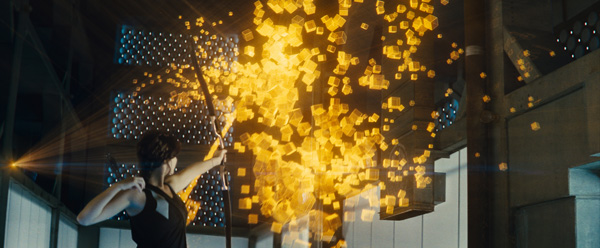 |
|
While this describes the digital techniques, giving the performances and interactions with the live actors and the sets the right level of drama to work in the story required extensive previs. Scenes were blocked out in enough detail to make a previs cut that was locked before any motion capture actions were recorded. The choreography designed for this cut also allowed them to build the momentum of the targets’ performances from the beginning to the end of the sequence – how fast they ducked in and out of view, how the characters were written on by the lasers, and how quickly they shattered. 3D Laser Projection"Janek always likes to ground the design of any futuristic technology or gadgets in some aspect of actual physics,” said Paul. “He wanted the system that generated the holographic characters to be a visible part of the archery station environment and, because these were 3D projections we agreed that there would always be at least three beams required to create a fully rendered character." |
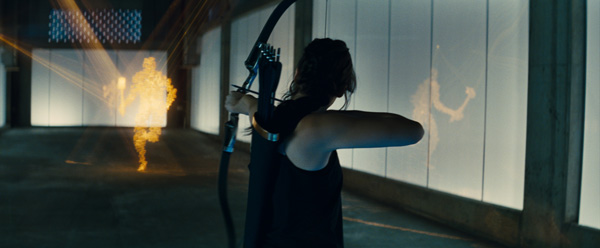 |
|
Because the laser beam projections needed to work and interact accurately with the performances of the targets and the live actor, they were included at the previs stage but were only designed and added to the composites after the motion was finalised. To make sure these beams made sense within the story to the audience, CG projector heads were added to the set to provide a plausible mechanism for the holograms. The CG light projected by the heads was then treated according to real-world physics. Starting with the projectors, beams and character models produced by the CG artists, the compositors focused on developing looks, especially for the target characters and they way they were generated. Compositing supervisor Matthew Greig said, “We needed to retain some physical accuracy, despite the slightly fantastical premise. We didn't want the projected laser beams to simply end at the character, so we continued the beam projections beyond the character, at a lesser intensity, and had them tracing the laser shadow of the cubes onto the set, wherever that happened to be – the floor, windows, pipes and sometimes Katniss herself. This created a lot more visual activity and really helped us sell her presence in this chaotic environment and embed her into the shots. |
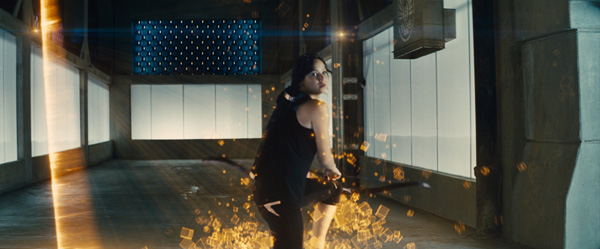 |
Light CubesThis involved creating readable cubes, handled as back-facing and front facing objects, in order to preserve the solid depth of the model and also to control how transparent any part of it should look at any moment. “It was important to the director that the holo-targets retain some transparency, yet have a consistent density, so that the viewer understands that the character is constructed from the light cubes. That meant being able to clearly read the cubes that made up the rear of the character, through the front cubes. The confluence of these cubes would provide the density, particularly around the torso,” Matthew said. “The compositors then created an extra layer of activity by adding a stroboscopic effect to mimic the effect of the sweeping laser being caught by a perceived double-printing due to the 24 frames per second of the footage. We generated a line element in Nuke which we could then procedurally animate, allowing us to customise the scene on a per-shot basis. We placed this element on cards, parented to the CG projectors, in Nuke's 3D environment and dialled in the speed and spread of what we dubbed the ‘scintillators’.” |
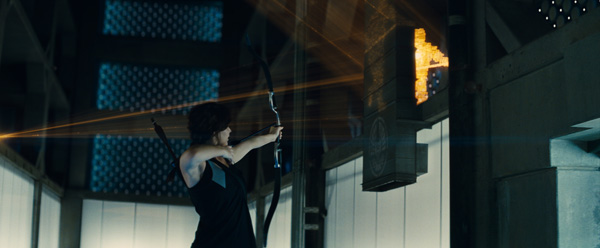 |
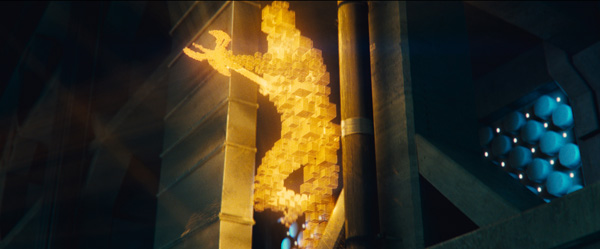 |
|
The combination of these CG and composited elements gave a level of chaotic activity to suit the drama, while keeping a mechanical precision and rhythm to the choreography of the lasers across the sequence. The compositors continued to refine the looks on-the-fly, as the characters were put together. Nuke TemplateThe CG set-ups for scenes were designed in a modular fashion to fit within a Nuke template, in order to make specific revisions on such qualities as lighting one area at a time instead of having to entirely rebuild the scenes every time they needed to make a change. They established a firm but flexible template in Nuke that allowed them to accommodate changes in the holo-target builds from the director and supervisor and to populate them across the sequence, with minimal disruption to the workflow. The lighting for each scene comprised the light shining from the set walls, the camera crew’s practical lights and the self-illuminated character. The target could appear as a bright object on either a dark or a bright background, and part of the work was developing a look that was effective in both situations. Matthew said, “Holo-targets might be running through dark areas of the set, or appear atop the brighter panels in the lower area of the training room. We had to find the right balance between the brightness of the plate and our holograms, retaining their incandescent nature without losing them over the bright backgrounds.” |
 |
|
A deep compositing approach, which the Animal Logic team had developed and customized especially when working on the Orrery in ‘Prometheus’, was useful in some instances but to a much lesser degree than it had been on that previous movie. “Where we found it useful on ‘Catching Fire’ was for precisely controlling the depth-of-field for the very fine lasers. Where the lasers were spread over a large Z-distance and were criss-crossed, having the deep data allowed us to treat the individual lasers without the need to split them all into separate CG passes,” Matthew explained. Architectural ElementsThe team went on to create set extensions within the archery station. The sequence was shot in a car park in which the set was dressed only at the lower level to provide an in-camera background for a significant amount of the action. Enhancements were always planned for the upper levels and some of the existing car park infrastructure to ensure the location was transformed into a suitable futuristic arena. While a LIDAR scan had been made of the set during the shoot to assist with the CG extension work, it was decided to forgo any green screen and rotoscope the cast and existing set elements as required. |
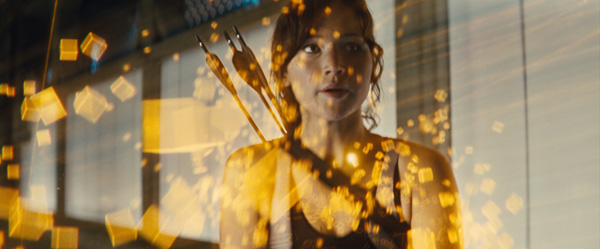 |
|
The extensions required background walls on all of the upper levels, adding some architectural elements to the existing concrete structures as well as the laser beam projector heads. The design of the set extension incorporated what Paul called 1970s retro-futuristic design cues, taken from other parts of the Training Centre set and also inspiration from the production design of films such as ‘The Man Who Fell to Earth’. In the plates, Katniss had only had the ambient lights on the existing set shining on her, so that when the compositors adjusted, changed the colour or augmented the lights in the extensions, her lighting had to be adjusted accordingly. “Lights are critical to modern compositing, such as the small reflections, lights in people’s eyes, adding the integration and realism that sell the shots,” Paul said. The compositing team received the set extensions as tracked and lit assets. The compositors controlled colour and lighting, in particular the characteristic soft blue colour of lights along the floor and in the walls, and the LED pin lights. In some cases, where the camera was very close to the CG asset, they re-projected the plate photography onto the CG asset in Nuke to allow a seamless join between plate and CG. They also performed some cleanup on the live action plates to remove excess pipes and cabling, and added the Capitol logo motif to the practical air ducts from the location. |
 |
Score BoardThat retro-futuristic style was extended over into Fuel’s motion graphics work on the weapon activation and score board screens Katnis uses in the shooting range, carried out by the team’s motion artist Anna Fraser. The glyphs and animations for the graphics were designed in this same style. The shots were tricky to composite because as the actress walks forward she needs to tap selections onto this screen, though she had no physical reference on set, and the composite had to include interactive lighting. “Anna had animated these to the timings of the plates and then rendered the panels out of After Effects as an element, which we projected in Nuke's 3D workspace into the shot using the camera from the tracking department,” Matthew said. “The compositors had to refine the position of the element quite precisely in the composite to work with the performance. Fuel was responsible for all of the glyphs, lights and motion for the screen, including subtle video effects like the high frequency flicker and field break-up, and interactive lights. An interesting continuity task involved in the archery range sequences was keeping track of the arrows in Katnis’ quiver. Shooting practical arrows on set was obviously not an option. She had a certain number of arrows in the quiver for the team to start with but as she never actually used them, they had to not only create and send CG arrows from her bow across the set as she shot, but also make sure they remained in the shot and didn’t simply disappear, and that the number of arrows left in the quiver decreased by the correct amount. A 3D layout determined the orientation of her bow in 3D space, which then dictated the trajectory of the arrow at the time she releases the string. www.animallogic.com/Fuel/Work |
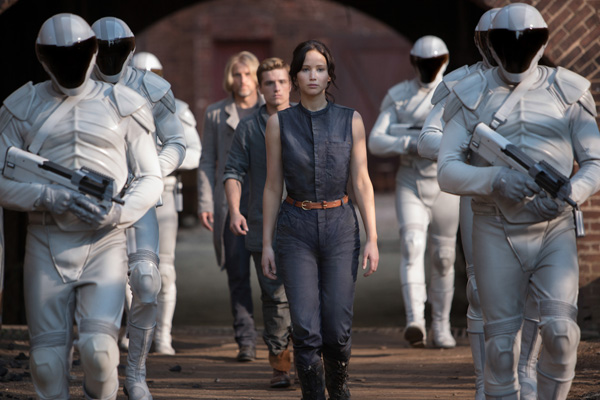 |
Building the Victor's VillageMethod Studioscontributed 155 shots of effects and environments to the movie that appear early in the story when the audience meets Katniss Everdeen and Peeta Mellark again just six months after winning the 74th Hunger Games. They have returned to their coal mining town in District 12, living in a grand house in the Victor's Village. The village environment is a full 3D build, created to extend two partial houses the production had built on set. A further eight houses were created digitally, and the snow covered ground was extended out around them. The plates had been shot with partial blue screen under varying lighting conditions, and falling snow effects were added to complete the scene. Method only began working on the project when the shoot was nearly over and didn’t have the benefit of visiting the set themselves, nevertheless, Method Studios’ VFX supervisor Stephane Nase said that the level of expectation across the production for this film was very high. The production had captured thousands of images from set and supplied them to the team with two concept drawings and blueprints for the half-buildings on set. |
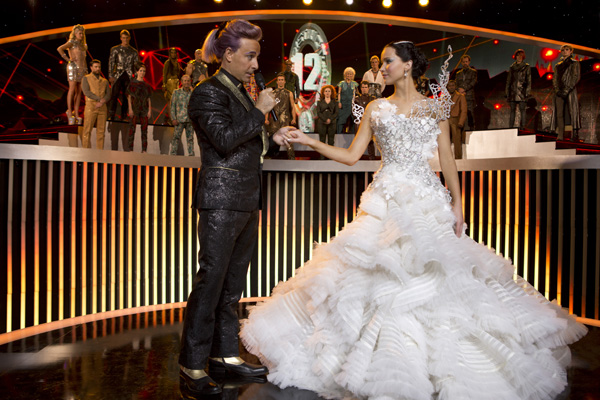 |
|
“As the camera moves around quite a bit in the village sequences, both in terms of angle, lights and closeness, we defined the maximum level of detail we would need by working on the most close-up of our shots,” Stephane said. “Where complete houses had to be built up, we projected a lot of images onto the models and relit everything digitally. The direction of light and the atmosphere were different in all the sequences, which included daytime and night shots, and this point in particular led to our choice of a CG environment and not a matte painting.” Robotic CamerasDuring one of the night scenes, the lead characters are being interviewed for television under two large spotlights while a pair of large, inquisitive robotic cameras crane around them for close-up views. After Method’s art department improved on the design provided by the client, the team built and animated these cameras as full digital assets through concept, modelling and surfacing. For a moment the production camera takes the characters’ point of view, looking into the robot's blue spotlight and lens with their reflection in it. The effect created is based on a real lens - they projected the actors on a card to show a correct reflection on the lens. The plate included the actors, the two spotlights and the floor in the foreground. Everything else - village, trees, snow and sky - are CG. The light on the actors in fact came from off-camera reflectors and not from the two spots inside the frame. |
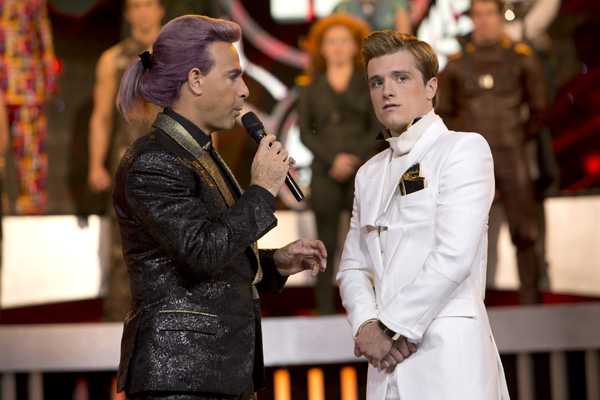 |
Caesar’s Girl on FireWhen the action moves to Katniss and Peeta’s appearance on Caesar's theatre show, the production had again built only a small section of stage set and audience was shot on green screen. The theatre design was also taken through a concept process to extend the auditorium and provide dramatic lighting for Katniss's fiery dress transformation and the appearance of her winged costume. “The physical set included the stage, Caesar, Katniss and Peeta, and the first four rows of the audience. Beyond this, the theatre and audience extension are full CG. Method received initial concept art, but we took an active role in designing the theatre and created a new design from scratch,” Stephane said. “The green screen shoot of the audience resulted in perfect imagery for the theatre crowd work. All the different actions we needed for the script had been shot from three different angles – frontal plus 45° to the left and to the right. From this section of audience, elements were replicated on cards for re-use around the theatre, and were varied by introducing 3D elements.” The task of creating the dress transformation and enhancing the costume's wings was begun without artwork and concepts. After look development and various tests were done in early in compositing and quickly in CG, they chose to make as much use as possible of the original plate for the transformation and not turn to entirely CG shots as a solution for the effect. “We actually used three plates – a clean plate for the stage and Caesar, a second for Katniss wearing her white dress, and a third of Katniss in a black dress,” Stephane explained. |
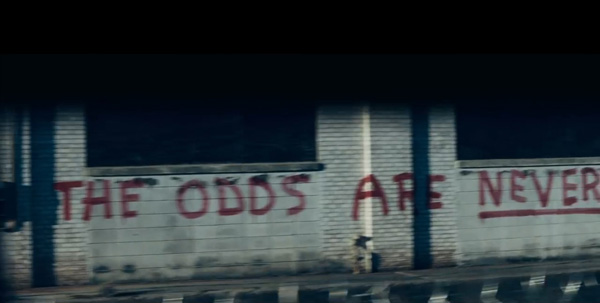 |
|
“The primary step was to carefully match the two plates of Katniss in terms of timing and framing, completing the warp, retiming and cleanup in Nuke. We changed the topology of the two dresses, making the white dress thinner and black dress thicker, to create a digital transition between both. Then, in compositing, we were able to use a maximum of the real dresses and resort to CG only for the transition and effect, producing a very realistic result.” Even so, getting the fire simulation to work well with the actor’s moves was a long, precise process relying on the tracking data from set. Train Tunnel TransitionAnother dramatic scene that creates a major transition in the story occurs as Katniss and Peeta travel through a tunnel to District 11. Method created a full CG environment looking out the back of the observation car of the train as it leaves behind a lush green landscape and passes through a dark, ominous tunnel where graffiti of the Mockingjay logo is lit by flashes of light, before exiting again to reveal an enormous threatening security wall with fences, soldiers and trucks, all realised digitally. “In this case we received a concept for the tunnel and for the graffiti, although our art department improved on these and presented them to the client for approval. The tunnel asset was built to place the train footage inside, keeping everything consistently positioned inside it as the train moves through, by trying out different layouts to establish the speed of the train at about 45mph, and define the length of it,” said Stephane. |
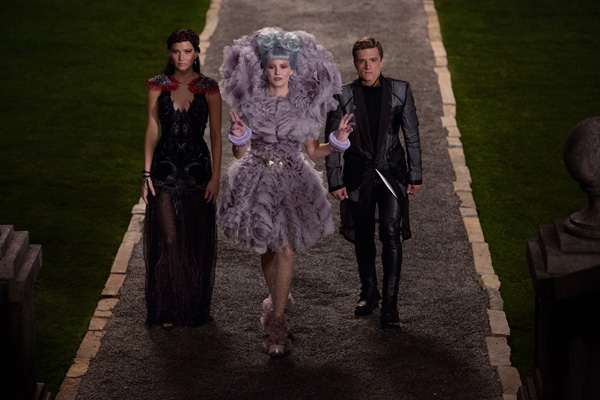 |
| The lights inside the train with the actors need to change significantly from the beginning to the end of the sequence. To control them, the team removed as many existing lights as possible from inside the train, originating in the plate, and added CG light interactions by building out the carriage with all the details and matching the established speed. The timing of the camera was also adjusted slightly in few shots as the train passes by the graffiti. The security wall, fences, soldiers and trucks all had to match the shots following the tunnel sequence, and were based on the plates from the shoot and texture photography as reference to build the soldiers, trucks and fences. The main emphasis was on consistency throughout the cut. Night of CelebrationAs Katniss and Peeta approach the Capitol Mansion, prepared and lit up for a night of celebration, the scene called for a large animated 3D matte painting at 8K, 8,000 x 6,000 pixels. The reference provided from the production was Place Vendome in central Paris, a wide open square surrounded by elegant buildings. A similar sense of scale and grandeur has been kept but the architecture of the buildings has been adapted to match the design and looks of the Capitol as established by the main VFX vendor Double Negative across the rest of the film. Water jets and other subtle movements were added. Because the animations and lights inside it needed to work with the live action as the camera cuts between the painting and looks back at the actors approaching, the artists received a preliminary edit including the shots with Katniss’ entrance. www.methodstudios.com |
|
Words: Adriene Hurst |


















